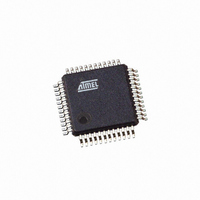AT91SAM7S32B-AU Atmel, AT91SAM7S32B-AU Datasheet - Page 449

AT91SAM7S32B-AU
Manufacturer Part Number
AT91SAM7S32B-AU
Description
IC MCU ARM7 32KB FLASH 48LQFP
Manufacturer
Atmel
Series
AT91SAMr
Datasheet
1.AT91SAM7S16-MU.pdf
(779 pages)
Specifications of AT91SAM7S32B-AU
Core Processor
ARM7
Core Size
16/32-Bit
Speed
55MHz
Connectivity
I²C, SPI, SSC, UART/USART
Peripherals
Brown-out Detect/Reset, DMA, POR, PWM, WDT
Number Of I /o
21
Program Memory Size
32KB (32K x 8)
Program Memory Type
FLASH
Ram Size
8K x 8
Voltage - Supply (vcc/vdd)
1.65 V ~ 1.95 V
Data Converters
A/D 8x10b
Oscillator Type
Internal
Operating Temperature
-40°C ~ 85°C
Package / Case
48-LQFP
Cpu Family
91S
Device Core
ARM7TDMI
Device Core Size
32b
Frequency (max)
55MHz
Interface Type
SPI/TWI/USART
Total Internal Ram Size
8KB
# I/os (max)
21
Number Of Timers - General Purpose
3
Operating Supply Voltage (typ)
1.8/3.3V
Operating Supply Voltage (max)
1.95/3.6V
Operating Supply Voltage (min)
1.65/3V
On-chip Adc
8-chx10-bit
Instruction Set Architecture
RISC
Operating Temp Range
-40C to 85C
Operating Temperature Classification
Industrial
Mounting
Surface Mount
Pin Count
48
Package Type
LQFP
Package
48LQFP
Family Name
AT91
Maximum Speed
55 MHz
Operating Supply Voltage
1.8|3.3 V
Data Bus Width
32 Bit
Number Of Programmable I/os
21
Number Of Timers
3
For Use With
AT91SAM-ICE - EMULATOR FOR AT91 ARM7/ARM9AT91SAM7S-EK - KIT EVAL FOR ARM AT91SAM7S
Lead Free Status / RoHS Status
Lead free / RoHS Compliant
Eeprom Size
-
Lead Free Status / Rohs Status
Compliant
Available stocks
Company
Part Number
Manufacturer
Quantity
Price
Part Number:
AT91SAM7S32B-AU
Manufacturer:
MICROCHIP/微芯
Quantity:
20 000
- Current page: 449 of 779
- Download datasheet (11Mb)
33.5.7
33.5.8
33.5.9
6175K–ATARM–30-Aug-10
Capture Operating Mode
Capture Registers A and B
Trigger Conditions
•
•
•
The channel can also be configured to have an external trigger. In Capture Mode, the external
trigger signal can be selected between TIOA and TIOB. In Waveform Mode, an external event
can be programmed on one of the following signals: TIOB, XC0, XC1 or XC2. This external
event can then be programmed to perform a trigger by setting ENETRG in TC_CMR.
If an external trigger is used, the duration of the pulses must be longer than the master clock
period in order to be detected.
Regardless of the trigger used, it will be taken into account at the following active edge of the
selected clock. This means that the counter value can be read differently from zero just after a
trigger, especially when a low frequency signal is selected as the clock.
This mode is entered by clearing the WAVE parameter in TC_CMR (Channel Mode Register).
Capture Mode allows the TC channel to perform measurements such as pulse timing, fre-
quency, period, duty cycle and phase on TIOA and TIOB signals which are considered as
inputs.
Figure 33-5
Registers A and B (RA and RB) are used as capture registers. This means that they can be
loaded with the counter value when a programmable event occurs on the signal TIOA.
The LDRA parameter in TC_CMR defines the TIOA edge for the loading of register A, and the
LDRB parameter defines the TIOA edge for the loading of Register B.
RA is loaded only if it has not been loaded since the last trigger or if RB has been loaded since
the last loading of RA.
RB is loaded only if RA has been loaded since the last trigger or the last loading of RB.
Loading RA or RB before the read of the last value loaded sets the Overrun Error Flag (LOVRS)
in TC_SR (Status Register). In this case, the old value is overwritten.
In addition to the SYNC signal, the software trigger and the RC compare trigger, an external trig-
ger can be defined.
The ABETRG bit in TC_CMR selects TIOA or TIOB input signal as an external trigger. The
ETRGEDG parameter defines the edge (rising, falling or both) detected to generate an external
trigger. If ETRGEDG = 0 (none), the external trigger is disabled.
Software Trigger: Each channel has a software trigger, available by setting SWTRG in
TC_CCR.
SYNC: Each channel has a synchronization signal SYNC. When asserted, this signal has
the same effect as a software trigger. The SYNC signals of all channels are asserted
simultaneously by writing TC_BCR (Block Control) with SYNC set.
Compare RC Trigger: RC is implemented in each channel and can provide a trigger when
the counter value matches the RC value if CPCTRG is set in TC_CMR.
shows the configuration of the TC channel when programmed in Capture Mode.
AT91SAM7S Series Preliminary
449
Related parts for AT91SAM7S32B-AU
Image
Part Number
Description
Manufacturer
Datasheet
Request
R

Part Number:
Description:
KIT EVAL FOR ARM AT91SAM7S
Manufacturer:
Atmel
Datasheet:

Part Number:
Description:
MCU, MPU & DSP Development Tools KICKSTART KIT ATMEL AT91SAM7S
Manufacturer:
IAR Systems

Part Number:
Description:
DEV KIT FOR AVR/AVR32
Manufacturer:
Atmel
Datasheet:

Part Number:
Description:
INTERVAL AND WIPE/WASH WIPER CONTROL IC WITH DELAY
Manufacturer:
ATMEL Corporation
Datasheet:

Part Number:
Description:
Low-Voltage Voice-Switched IC for Hands-Free Operation
Manufacturer:
ATMEL Corporation
Datasheet:

Part Number:
Description:
MONOLITHIC INTEGRATED FEATUREPHONE CIRCUIT
Manufacturer:
ATMEL Corporation
Datasheet:

Part Number:
Description:
AM-FM Receiver IC U4255BM-M
Manufacturer:
ATMEL Corporation
Datasheet:

Part Number:
Description:
Monolithic Integrated Feature Phone Circuit
Manufacturer:
ATMEL Corporation
Datasheet:

Part Number:
Description:
Multistandard Video-IF and Quasi Parallel Sound Processing
Manufacturer:
ATMEL Corporation
Datasheet:

Part Number:
Description:
High-performance EE PLD
Manufacturer:
ATMEL Corporation
Datasheet:

Part Number:
Description:
8-bit Flash Microcontroller
Manufacturer:
ATMEL Corporation
Datasheet:

Part Number:
Description:
2-Wire Serial EEPROM
Manufacturer:
ATMEL Corporation
Datasheet:











